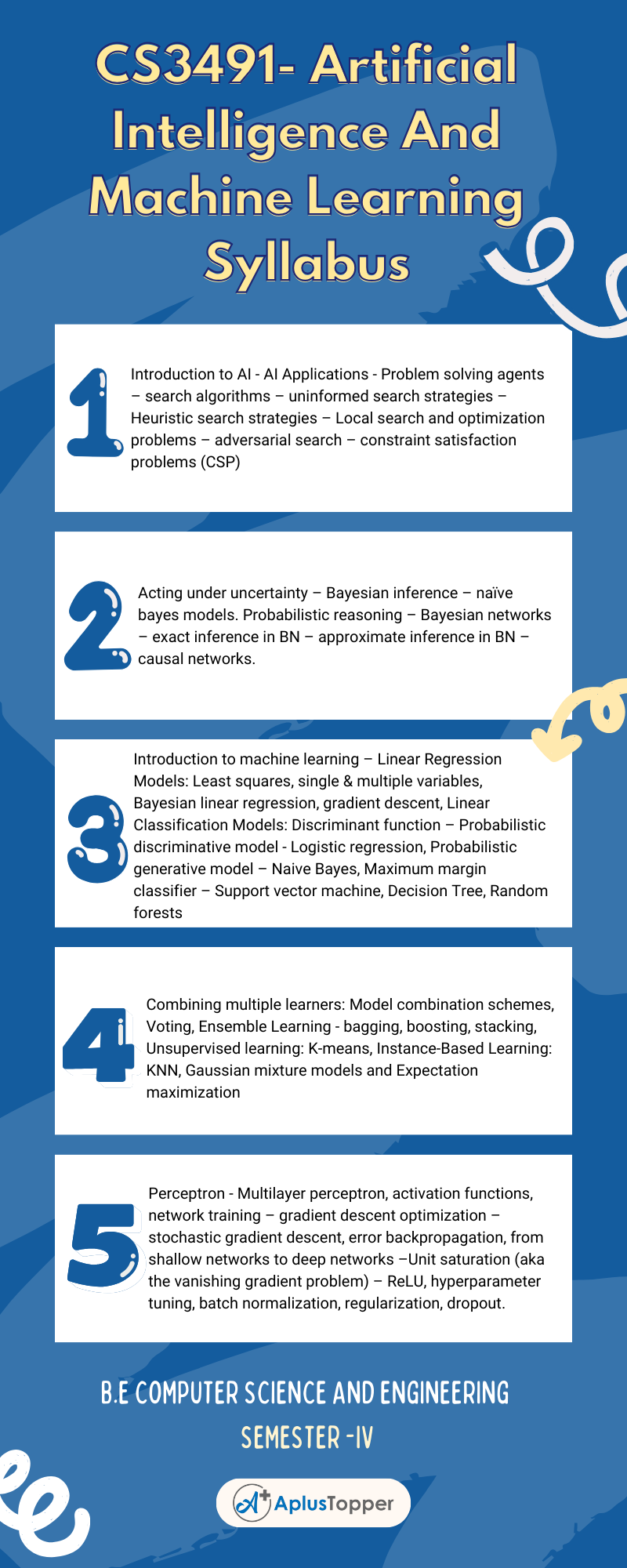Anna University, Subject code – CS3491, deals with the B.E Computer Science and Engineering Semester -IV Artificial Intelligence And Machine Learning syllabus regulation 2021 relating to affiliated institutions. From here, Students can get assistance in preparing notes to excel in academic performance.
We include every topic of the Artificial Intelligence And Machine Learning Syllabus, to understand the subject very well. It will help you to improve your idea of syllabus of CS3491-Artificial Intelligence And Machine Learning Syllabus on your finger tips to go ahead in a clear path of preparation. In this following article Artificial Intelligence And Machine Learning Syllabus, will help you, Hope you share with your friends.
If you want to know more about the syllabus of B.E Computer Science and Engineering connected to an affiliated institution’s under four-year undergraduate degree programme. We provide you with a detailed Year-wise, semester-wise, and Subject-wise syllabus in the following link B.E Computer Science and Engineering Syllabus Anna University, Regulation 2021.
Aim Of Concept:
The main objectives of this course are to:
- Study about uninformed and Heuristic search techniques.
- Learn techniques for reasoning under uncertainty
- Introduce Machine Learning and supervised learning algorithms
- Study about ensembling and unsupervised learning algorithms
- Learn the basics of deep learning using neural networks
CS3491- Artificial Intelligence And Machine Learning Syllabus
Unit I: Problem Solving
Introduction to AI – AI Applications – Problem solving agents – search algorithms – uninformed search strategies – Heuristic search strategies – Local search and optimization problems – adversarial search – constraint satisfaction problems (CSP)
Unit II: Probabilistic Reasoning
Acting under uncertainty – Bayesian inference – naïve bayes models. Probabilistic reasoning – Bayesian networks – exact inference in BN – approximate inference in BN – causal networks.
Unit III: Supervised Learning
Introduction to machine learning – Linear Regression Models: Least squares, single & multiple variables, Bayesian linear regression, gradient descent, Linear Classification Models: Discriminant function – Probabilistic discriminative model – Logistic regression, Probabilistic generative model – Naive Bayes, Maximum margin classifier – Support vector machine, Decision Tree, Random forests
Unit IV: Ensemble Techniques And Unsupervised Learning
Combining multiple learners: Model combination schemes, Voting, Ensemble Learning – bagging, boosting, stacking, Unsupervised learning: K-means, Instance-Based Learning: KNN, Gaussian mixture models and Expectation maximization

Unit V: Neural Networks
Perceptron – Multilayer perceptron, activation functions, network training – gradient descent optimization – stochastic gradient descent, error backpropagation, from shallow networks to deep networks –Unit saturation (aka the vanishing gradient problem) – ReLU, hyperparameter tuning, batch normalization, regularization, dropout.
Practical Exercises:
- Implementation of Uninformed search algorithms (BFS, DFS)
- Implementation of Informed search algorithms (A*, memory-bounded A*)
- Implement naïve Bayes models
- Implement Bayesian Networks
- Build Regression models
- Build decision trees and random forests
- Build SVM models
- Implement ensembling techniques
- Implement clustering algorithms
- Implement EM for Bayesian networks
- Build simple NN models
- Build deep learning NN models
Text Books:
- Stuart Russell and Peter Norvig, “Artificial Intelligence – A Modern Approach”, Fourth Edition, Pearson Education, 2021.
- Ethem Alpaydin, “Introduction to Machine Learning”, MIT Press, Fourth Edition, 2020.
References:
- Dan W. Patterson, “Introduction to Artificial Intelligence and Expert Systems”, Pearson Education,2007
- Kevin Night, Elaine Rich, and Nair B., “Artificial Intelligence”, McGraw Hill, 2008
- Patrick H. Winston, “Artificial Intelligence”, Third Edition, Pearson Education, 2006
- Deepak Khemani, “Artificial Intelligence”, Tata McGraw Hill Education, 2013 (http://nptel.ac.in/)
- Christopher M. Bishop, “Pattern Recognition and Machine Learning”, Springer, 2006.
- Tom Mitchell, “Machine Learning”, McGraw Hill, 3rd Edition,1997.
- Charu C. Aggarwal, “Data Classification Algorithms and Applications”, CRC Press, 2014
- Mehryar Mohri, Afshin Rostamizadeh, Ameet Talwalkar, “Foundations of Machine Learning”, MIT Press, 2012.
- Ian Goodfellow, Yoshua Bengio, Aaron Courville, “Deep Learning”, MIT Press, 2016
Related Posts On Semester – IV:
- CS3452 – Theory of Computation
- CS3492 – Database Management Systems
- CS3401 – Algorithms
- CS3451 – Introduction to Operating Systems
- GE3451 – Environmental Sciences and Sustainability
